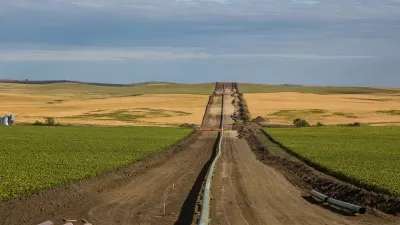Iowa Governor Terry Branstad supports the Keystone XL Pipeline, as do most Republican leaders. Then again, it doesn't go through his state. Not so for the newly proposed Bakken Pipeline that cuts across the heart of Iowa. No word on his position yet.
"Branstad told reporters Monday (July 14) at his weekly Iowa Capitol news briefing that he first learned of plans for the 1,100-mile crude oil pipeline last week from news reports. He said was not aware of the proposal by Energy Transfer Partners, L.P., of Dallas, Texas," writes William Petroski of The Des Moines Register.
"I have not taken a position on it. I just want to learn more about it," Branstad said.
However, he's already distinguished the two pipelines - giving him reason to pause before supporting the 'job-creating' pipeline "which would cut across 17 Iowa counties en route from North Dakota to Illinois," from the job-creating Keystone pipeline that doesn't go through Iowa (see map).
Branstad said that the proposed Bakken Pipeline, which would require approvals from the Iowa Utilities Board and the Iowa Department of Natural Resources, is different from the proposed Keystone XL pipeline because it would cross land that is more intensively farmed, including Iowa cropland with drainage tiles.
Pipelines can be messy, and I'm not referring to potential spills, of which we have reported many here. There's that issue of eminent domain that is sure to anger the locals. In fact, a court case involving eminent domain was cited as the reason the State Department has delayed its decision on Keystone XL.
If the pipeline is approved by the Iowa Utilities Board, the pipeline builders could use eminent domain to acquire easements to construct the pipeline through Iowa farmland, according to state officials. Branstad said eminent domain is a "controversial subject" but it can be warranted for a public purpose such as construction pipelines, roads or bridges.
Already Branstad's gubernatorial opponent has seized the issue. Grant Woodard, campaign manager for state Sen. Jack Hatch, D-Des Moines "issued a statement after Branstad's news conference with a headline claiming that the Republican governor supports the use of eminent domain for 'Big oil's pipeline across Iowa.'"
The irony is that "the volatile Bakken crude is already being transported by two freight railroads through nine Iowa counties, raising fears about possible train accidents," writes Petroski in USA Today. Placing the oil in a pipeline underground would largely eliminate the public safety threat associated with crude-by-rail explosions in Casselton, N.D. and Lac Mégantic, Quebec.
The Bakken Pipeline poses conflicts not only for Keystone supporters but Keystone opponents as well. Environmentalists who oppose Keystone and are concerned about the environmental and public safety hazards of moving millions of barrels of oil by rail daily should think carefully before staking out a position on the Bakken Pipeline.
The Sierra Club's national office has staked-out a position that "crude-by-rail is dangerous to communities" while their Iowa chapter has focused on the routing, according to USA Today.
Neila Seaman, director of the Iowa chapter of the Sierra Club, said, "We would not support the pipeline going through any protected areas or near aquifers or things like that...It is a pipeline, and pipelines break."
Hat tip to Alex Guillén and POLITICO Morning Energy, July 15.
FULL STORY: Branstad undecided on Iowa oil pipeline plans

Alabama: Trump Terminates Settlements for Black Communities Harmed By Raw Sewage
Trump deemed the landmark civil rights agreement “illegal DEI and environmental justice policy.”

Study: Maui’s Plan to Convert Vacation Rentals to Long-Term Housing Could Cause Nearly $1 Billion Economic Loss
The plan would reduce visitor accommodation by 25% resulting in 1,900 jobs lost.

Why Should We Subsidize Public Transportation?
Many public transit agencies face financial stress due to rising costs, declining fare revenue, and declining subsidies. Transit advocates must provide a strong business case for increasing public transit funding.

Paris Bike Boom Leads to Steep Drop in Air Pollution
The French city’s air quality has improved dramatically in the past 20 years, coinciding with a growth in cycling.

Why Housing Costs More to Build in California Than in Texas
Hard costs like labor and materials combined with ‘soft’ costs such as permitting make building in the San Francisco Bay Area almost three times as costly as in Texas cities.

San Diego County Sees a Rise in Urban Coyotes
San Diego County experiences a rise in urban coyotes, as sightings become prevalent throughout its urban neighbourhoods and surrounding areas.
Urban Design for Planners 1: Software Tools
This six-course series explores essential urban design concepts using open source software and equips planners with the tools they need to participate fully in the urban design process.
Planning for Universal Design
Learn the tools for implementing Universal Design in planning regulations.
Smith Gee Studio
Alamo Area Metropolitan Planning Organization
City of Santa Clarita
Institute for Housing and Urban Development Studies (IHS)
City of Grandview
Harvard GSD Executive Education
Toledo-Lucas County Plan Commissions
Salt Lake City
NYU Wagner Graduate School of Public Service



























